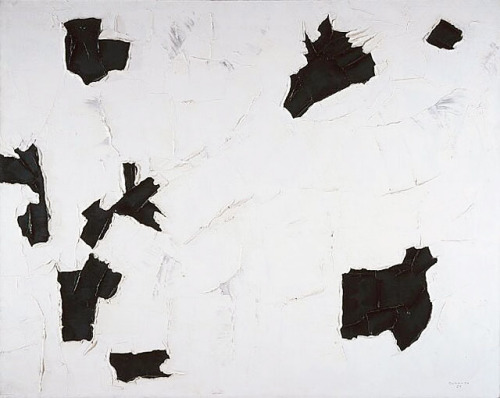We are a small and humble people clutching the robes of priests who've become sole guardians of faith, knowledge, truth and our national heritage; and we have been shielded from the perilous evolution of thought going on all around us, by well intentioned but misguided educators who distorted the great facts of history whenever they found it impractical to keep us totally ignorant.
As early as 1760, this colony was cast behind slick walls of fear (the normal refuge of defeated peoples) and abandoned there, for the first time. Our leaders sailed away, or sold themselves to the highest bidder, as they have done ever since, whenever they had the chance.” - Paul-Émile Borduas
.jpg)
 Paul-Émile Borduas, who was the head of the Automatistes, taught at L’École du Meuble until getting fired for publishing the group's manifesto Refus Global. With influences like André Breton, Paul Klee and Wasily Kandinsky the Automatistes would go and adapt the Surrealist maxim of “attempting to give pictorial form to the workings of the subconscious.” The groups formalism is best viewed as a variation of abstract expressionism. Refus Global in Québec was seen as a major provocation. The polemic supposedly lead to mine protest, which was already a desperate situation as seen in Claude Jutra’s Mon Oncle Antoine. Dénis Arcand would further examine worker dissatisfaction in On est au Cotton. These antecedents of left-wing Québécois directors and their radical and unruly spirit are at heart of the films of Denis Côté.
Paul-Émile Borduas, who was the head of the Automatistes, taught at L’École du Meuble until getting fired for publishing the group's manifesto Refus Global. With influences like André Breton, Paul Klee and Wasily Kandinsky the Automatistes would go and adapt the Surrealist maxim of “attempting to give pictorial form to the workings of the subconscious.” The groups formalism is best viewed as a variation of abstract expressionism. Refus Global in Québec was seen as a major provocation. The polemic supposedly lead to mine protest, which was already a desperate situation as seen in Claude Jutra’s Mon Oncle Antoine. Dénis Arcand would further examine worker dissatisfaction in On est au Cotton. These antecedents of left-wing Québécois directors and their radical and unruly spirit are at heart of the films of Denis Côté.The thirty-eight-year old New Brunswick-born Denis Côté founded his production company Nihil Productions in 1993. At first he mostly made shorts but as he continued his first feature-length Les états nordiques (2005) won the Golden Leopard at Locarno (where since then, he has won a few Best Director prizes). Carcasses (2009) premiered at the Directors’ Fortnight at Cannes ; Côté was telling me he wants his next film to premiere at Berlin, a hybrid filmed at a Montreal zoo. Côté‘s films progress in vignettes with sequences that use metaphoric images. Like how in Curling the father visits his incarcerated wife, he watches a curling match and the two Bilodeau’s listen to the 80’s pop hit I Think We're Alone Now. The film captures a few days from the life of a father Jean-Francois, a motel cleaner who also works at a bowling lane, who isolates his daughter Julyvonne from public schools and all public contact. She now appears to be cognitively underdeveloped. It's texture is in the subtext as it explores the underlying character psychology.
 The Scot John Grierson in the 30’s with his advocacy for the ‘documentary’ and the birth of the National Film Board of Canada led to a strict format of how to use the cinematic medium to convey facts in Canadian documentaries. And then in the ‘60s there was a loosening of this scripture with the emergence of people like Arthur Lipsett and Serge Giguère (see: Robert Daudelin and Jean Pierre Lefebvre articles on Giguère in 24 Images, No. 151), which prolonged into the ‘80s with the Morin-Dufour collaborations and into the ‘90s with Donigan Cumming. The emphasis was on creating new forms of storytelling through digging towards unexplored subjects, the layering of fact and fiction, an emphasis on video, varied running times and alternative viewing outlets.
The Scot John Grierson in the 30’s with his advocacy for the ‘documentary’ and the birth of the National Film Board of Canada led to a strict format of how to use the cinematic medium to convey facts in Canadian documentaries. And then in the ‘60s there was a loosening of this scripture with the emergence of people like Arthur Lipsett and Serge Giguère (see: Robert Daudelin and Jean Pierre Lefebvre articles on Giguère in 24 Images, No. 151), which prolonged into the ‘80s with the Morin-Dufour collaborations and into the ‘90s with Donigan Cumming. The emphasis was on creating new forms of storytelling through digging towards unexplored subjects, the layering of fact and fiction, an emphasis on video, varied running times and alternative viewing outlets.Côté’s cinema might be that of “isolation” - as Adam Nayman insightfully points out to be a overriding theme for Côté - but the urgent message behind it is that, at the end, ‘isolation’ becomes a source of reflection that leads the characters to a change, re-opening themselves to the world. In relation to Canadian painting: the Perrault-Brault collaboration are most similar to Cornelius Kreighoff’s pastoral landscapes, Gilles Garles stylistic flourishes resembles William Kurelek highlighter colors and playful tone, and finally Denis Côté’s abstract lyricism is most similar to the formalism of the Automatistes painters. The heir of Borduas. – David Davidson
“Within a foreseeable future, men will cast off their useless chains. They will realize their full, individual potential according to the unpredictable, necessary order of spontaneity - in splendid anarchy.
Until then, we will not rest or falter. Hand in hand with others thirsting for a better life, no matter how long it takes, regardless of support or persecution, we will joyfully respond to a savage need for liberation.” - Paul-Émile Borduas

No comments:
Post a Comment